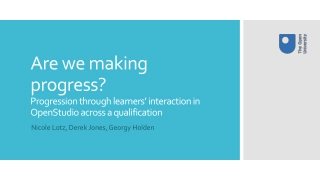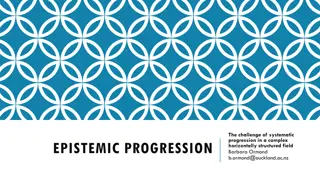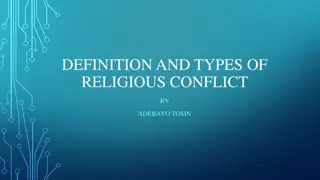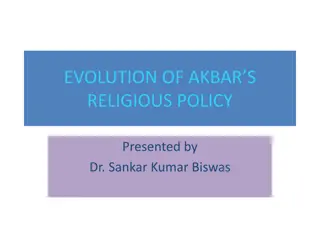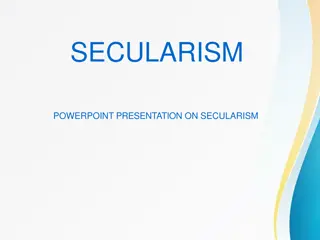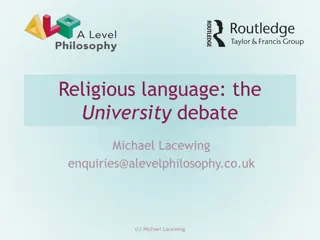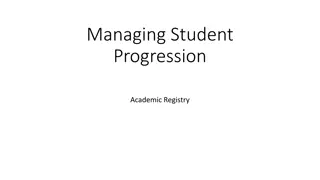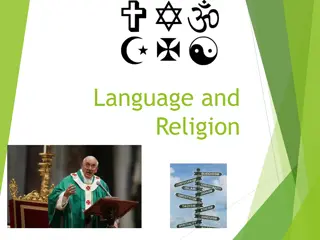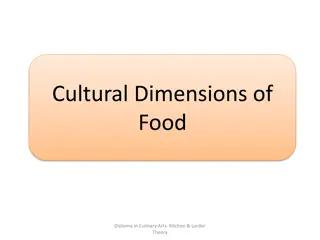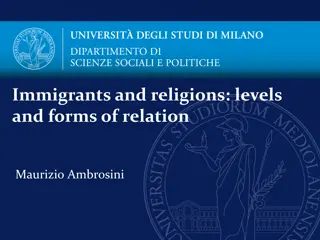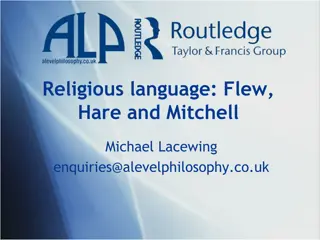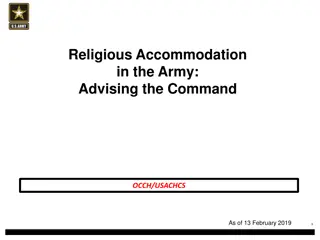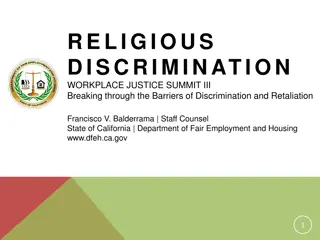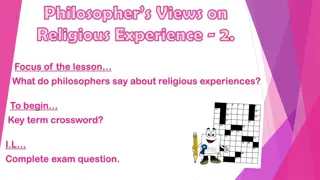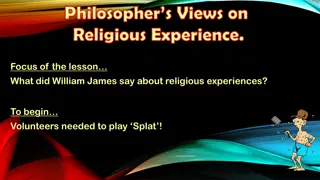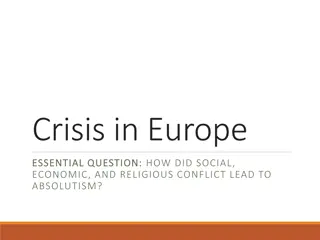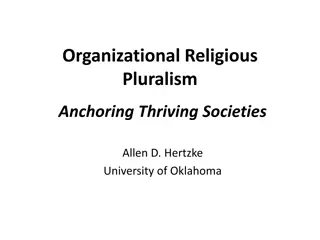Religious Education Skills Progression for Years 5 and 6
This document outlines the long-term plan for the RE curriculum for Year 5 and 6 students, focusing on topics such as living by Christian values, exploring wisdom from different faiths, understanding the creation of the world, and expressing faith through art. It also covers the progression of skills from EYFS to Year 6, including learning about different religions, religious symbols, places of worship, beliefs, and ethical questions. The curriculum aims to help students develop empathy, critical thinking, and a deeper understanding of religious practices and beliefs.
Download Presentation

Please find below an Image/Link to download the presentation.
The content on the website is provided AS IS for your information and personal use only. It may not be sold, licensed, or shared on other websites without obtaining consent from the author. Download presentation by click this link. If you encounter any issues during the download, it is possible that the publisher has removed the file from their server.
E N D
Presentation Transcript
RE Year 5 and 6
This LTP contains: RE skills progression document Long Term plan for cycle A Year 5/6 Term 1 Term 2 Term 3 Term 4 Term 5 Term 6 What would Jesus do? Can we live by Christian values in the 20th century? What can we learn from reflecting on Christian, Sikh and Muslim wisdom? Whose world is it anyway?How was the world created and why should I care about it today? What Is important to a Sikh in Britain today? Beliefs and actions in the world Expressing faith through art
RE Whole school progression of skills EYFS Year 1/2 Year 3/4 Year 5/6 Learning about Religion and Faith Be able to remember a Christian story and talk about it. Be able to use the right names for things that are special to Christians/ Jews. Be able tell a Christian story and talk about the meanings and what some people believe. Be able to talk about some of the things that are the same for different religious people. Be able to say what some Christian / Jewish symbols stand for. Be able to talk about different places of worship Be able to make links between the beliefs of different religious groups. Be able to describe and compare practises and experiences that are involved in belonging to different religious groups. Be able to explain religious beliefs using a range of religious vocabulary used by believers and suggest what they mean. To be able to explain why people belong to religions and how religion can make a difference to the lives of individuals and communities. To be able to explain how religious sources are used to provide answers to important questions about life and morality. To be able to explain the impact of religion on people's lives. To be able to investigate the significance of religion in the local, national and global communities. To be able to consider the meaning of a range of forms of religious expression and understand why they are important in religion. To be able to describe, and begin to understand, religious and other responses to ultimate and ethical questions. To be able to identify and begin to describe the similarities and differences within and between religions. To be able to use and interpret information about religions from a range of sources. Learning from Religion and Faith Be able to talk about things that happen to me. Be able to talk about what I find interesting or puzzling. Be able to talk about what is important to me and to other people Be able to ask about what happens to others with respect for their feelings. Be able to talk about some things in stories that make people ask questions. Be able to talk about what is important to me and to others with respect for their feelings. Be able to ask questions about who we are and where we belong, and suggest answers. Be able to ask questions about the meaning and purpose of life. I can use my knowledge of religions and my own experiences to suggest a range of answers. Be able to discuss moral decisions I and other people make. Be able to suggest what might happen as a result of different decisions, including those made with reference to religious beliefs / values. Be able to reflect on what it means to belong to a faith community, communicating my own responses. Be able to recognise the challenges of commitment within religions and compare this with their own commitments. Be able to discuss my own and others views of religious truth and belief, expressing my own ideas. Be able to reflect on ideas of right and wrong and my own and others responses to them. Be able to reflect on sources of inspiration in my own and others lives.
Year group: 5 and 6 Unit: What would Jesus do? (Can we live by the values of Jesus in the twenty-first century?) Focus religion : Christianity Religious concepts: Ministry (Christians believe that they should serve others and share with them the reasons for the service they offer); Responsibility (People have some degree of personal responsibility for the life they lead); Love (People can show their love by behaving in particular ways towards other people and the world they live in). Unit outcome: Explain the impact Jesus example and teachings might have on Christians today Express their own understanding of what Jesus would do in relation to amoral dilemma from the world today
Lesson LO/Skill Retrieval Key knowledge Lesson outcome/floor book expectation 1 mission Give each pupila choice of 4 pre- printed images, each on of an A4 sheet. Beige: a newspaper headline saying Good News Red: prison bars, with theword Freedom over the top Blue: an open eye, with the word Sight written on it Acandle with the word Blessed written on it. Pupils can take one, two or three of these, and complete them with a symbol, logo or reflective sentence. They are to be used for the border of the display that will be created over the next 6 lessons.The colourcoding helps to make a striking display Explore Jesus teachings and example and how they inspire Christians today. Know that Jesus' mission was to: to give poor people good news to free prisoners to help the blind to see to give liberty to oppressed people to tell people God would bless them this year. Know that all over the world today, Christians try to put Jesus mission into action. Know that the Catholic Church [is] responsible for one quarter of all healthcare provision. Globally, it runs 5,246 hospitals, 17,530 dispensaries, 577 leprosy clinics, 15,208 houses for the elderly and chronically ill and people with physical and learning difficulties worldwide... (Catholic Herald 2010) Skill: To be able to explain how religious sources are used to provide answers to important questions about life and morality. 2 Use some of Jesus stories, teachings and example to understand what Christians believe he meant by loving others Corinthian What was Jesus's mission? Know Saint Paul s Poem of Love from Corinthians 13:4-7 Know that it focuses on the Christian value of love Know that it is about 1950 years old, Know that it is read aloud in more weddings on earth than any other reading. Know that Saint Valentine s Day is a festival of love , but so too are Christmas, Easter and Pentecost in their own ways. respond in different ways such as through art work, linking to the artist Jim Dine s beautiful work on hearts (seen at the Tate). Pupils could create images of their ideas, questions and insights about love inside the hearts for a class display. Encourage creativity and rigorous thinking together. Ask pupils to use their literacy skills in a series of sentences about love using because/ my reason for this is/to explain further/ and one good Skill: To be able to explain how religious sources are used to provide answers to importantquestions about life and morality. examples is.
Lesson LO/Skill vocabulary Retrieval Key knowledge Lesson outcome/floor book expectation 3 LO:Use some of Jesus stories, teachings and example to understand why he saw forgiveness as so important debtor Tell your partner about St Paul's poem of love Parable of the Two Debtors, Luke 7:36 50 Know that In Jesus day, three rituals were common: a kiss of greeting, washing of feet, and anointing with oil Know that Simon, though, does not do any of these rituals know that The woman sees that Jesus has been offended by Simon s lack of greeting know that Woman is seen as a sinner Know that She anoints his feet with perfume; she weeps and wets them with tears, and she kisses them repeatedly. Know that Jesus then announces that her many sins have been forgiven as her great love has shown Parable of the Unforgiving Servant, Matthew 18:21 35, Know that One servant owed a large amount of money to the king Know thatT he king was lenient and didn't sell him and his family into slavery to sell it off Know that Another servant owed the first servant a small amount of money Know that The first servent sent him to prison for his debt Know thatThe king was angry that he had been lenient yet the servent had not, so punished him. Know that Jesus teaches that the Father is like the king, willing to show mercy and forgiveness to those that are also forgiving and willing to show mercy to others. Add some photos from the drama, You might add talk bubbles or think bubbles to the photos you choose, so that the stories and forgiveness scenarios are recalled. Skill: To be able to explain how religious sources are used to provide answers to important questions about life and morality.
Lesson LO/Skill vocabulary Retrieval Key knowledge Lesson outcome/floor book expectation 4 LO: Use some examples of Christian text (scripture and prayer) to understand the way Christians believe we should treat each other in modern times Retell the parable of the two debttors Know some of Mother Teresa's sayings: Pre-print onto some small cards the face of Mother Teresa and the sentence prompt Mother Teresa followed Jesus by... Ask children to complete the prompt and colour the card Encourage them to be original in the way they complete the card. Skill: To be able to explain how religious sources are used to provide answers to important questions about life and morality.
Lesson LO/Skill vocabulary Retrieval Key knowledge Lesson outcome/floor book expectation 5 LO:Use some of Jesus stories, teaching and examples to understand the way Christians believe we should handle wealth What was your favourite saying of Mother Teresa and why? The widows generosity parable Know that the rich gave large sums of money to God Know that A widow gave 2 coins to god Know that she had no source of income after her husband died Know that Jesus is teaching the disciples that it is not the amount of money given that is important, but rather the sacrifice made in the offering Know that the Christian charities- The Bible Society was given 8 million by supporters. The Church of England s Children s Society was given 23 million. Give pupils a copied outline of a coin, maybe 5 or 6 cm across Ask them to write three reasons to be generous onto the coin, and colour it. Add a section to the display. Skill: To be able to explain how religious sources are used to provide answers to important questions about life and morality. 6 LO:Discuss, argue about and develop a range of answers to moral dilemmas, using the teaching of Jesus to suggest what might be good or bad about different decisions. Think of reasons why some people try to live by Jesus; teaching and example in the modern world What is the meaning of the The widows generosity parable? Know that WWJD stand for What would Jesus do? Know that In 1896 the Kansas Congregational minister Charles Sheldon published a novel called In His Steps: What would Jesus do? Know that a youth leader in 1990 read the book and used the phrase Know that the phrase became really popular amongst Christians Know that the phrase was put on wristbands, clothing and other merchandise Know that it was to help christians to think about their choices. Give pupils the first paragraph of some simple stories about making choices. Theycould be based on the dilemmas above, or pupils could make up some more of their own. Ask them in pairs to develop two endings, which show the consequences of good choices or of bad choices.One story-pathway could show what happens if a person follows the teachings of Jesus, another could show what happens if someone does the opposite. Encourage pupils to think about consequences. Skill: To be able to explain how religious sources are used to provide answers to important questions about life and morality.
Year group: 5 and 6 Unit: What can we learn from reflecting on Christian, Sikh and Muslim wisdom? Focus religion : Christian, Sikh and Muslim Religious concepts: Authority(People will follow teachings that they consider to have status and integrity authority. The Scriptures of a religion have authority for followers of that faith.) Unit outcome: Use religious vocabulary to show their understanding of examples of Sikh, Muslim or Christian wisdom. Suggest varied answers to questions about meaning and purpose in the wisdom of the religions studied. Apply ideas of their own to understand wisdom from different religions. Describe clearly the wisdom that inspires me.
Key knowledge Lesson LO/Skill vocabulary Retrieval Lesson outcome/floor book expectation LO: To experience the practices of 'stilling', breathing exercises and tensing and focusing on parts of the body can help in using a relaxed mind for learning imaginatively. sk pupils to make an image/drawing of theirbreathing. They might use cloudsor lungs as a framework. Ask them to choose words or symbols that experience in the exercise. Discuss the outcomes in circle time. Alert Peace Quietness Reflection Relaxed Stillness Know that Learning to still body and mind can support learning know that it can lead to deeper thought processes and a sense of spirituality Know that breathing exercises can help learning imaginatively Know that tensing and focusing on parts of the body can help relax your mind 1 What does WWJD stand for? Why is it important to Christians? Know that Sikhism teaches that everyone is equal and that people living in poverty and suffering malnutrition should be helped. Know that Sikhs believe through dan, they can serve humanity by giving money to charity. Know that Sikhs consider Vand Chhakna - sharing what one earns, generosity, the giving of charity. Know that to Sikhs This is considered a religious duty because Sikhs believe this encourages compassion. Know that Sewa is giving selfless service to the community. This should be practised in all areas of a Sikh's life. LO:To understand Sikh teaching about the things that matter more than money, such as justice, service to others and appreciating the divine. 2 How can stilling adn breathing techniques help us? sk children to record their learning from Sikhism in an appropriate form (poster, poem, PPT). Guru Granth Sahib Sewa Vand Chhakna dan Skill: To be able to explain why people belong to religions and how religion can make a difference to the lives of individuals and communities.
Lesson LO/Skill vocabulary Retrieval Key knowledge Lesson outcome/floor book expectation LO:To explore and respond to ideas about creation from Islamic traditions Ask pupils in groups to select and organise twelve or thirteen images of the beauty of the earth, perhaps one for each month of theyear, as a calendar. Ask them toselect a Qur anic saying or a traditional Hadith to go with each of the images they choose. Khilafah Guardianship exploitation 3 What are Sewa Vand Chhakna Dan? Know that Many Muslims believe human beings have guardianship or khilafah of the planet Know that this means that each individual should act as a guardian or khalifah. Know thatThey will be held accountable for their guardianship on the Day of Judgement. Know that Humans should treat the world with respect, as it is not ours to abuse. Know that Guardianship allows humans to make use of the environment for their survival, but this must never be taken to the level of exploitation. Skill: To be able to explain the impact of religion on people's lives. LO:To describe and understand the teaching of St.Paul in the Bible about love, and to broaden and deepen their own understanding of the idea of love Know that Christians believe God has given humanity the gift of love Recap St Pauls poem of love from previous unit Give each pupil a copy of the text, centred on a page. Ask them to write reflections of their own about love around the edges, and to makes the text beautiful with calligraphy and decoration. 4 What do Khilafah Guardianship Exploitation meant to Muslims? Skill: To be able to explain the impact of reli gion on people's lives.
Lesson LO/Skill vocabulary Retrieval Key knowledge Lesson outcome/floor book expectation LO:To express their understanding of 'wisdom' creatively. What do Christians belive god gave them and how does it inspire them? Know that wisdom can be expressed in different ways Know that all religions studied have wise words Know that different people have different wisdom 5 Creative piece of work over this and last lesson Skill: Be able to reflect on sources of inspiration in my own and others lives. LO:To work collaboratively to create a shared selection of wise words. To learn about questions to do with the nature of sacred writing and holy texts, recognising and starting to understand the influence of such texts on millions of people over thousands of years Recap to support continuation of wisdom work All key knowledge from previous lessons 6 Skill: Be able to reflect on sources of inspiration in my own and others lives.
Year group: 5 and 6 Unit: Whose world is it anyway? How was the world created and why should I care about it today? Focus religion : Religious concepts: Belief(Our beliefs affect our actions) Responsibility(We are responsible for our actions) Interdependence(People and the natural world depend on each other) Unit outcome: Use a widening religious vocabulary to show some understanding about how belonging to a religion can involve taking responsibility for the environment. Use the vocabulary learned in RE, to show their understanding of different interpretations of how the world was created. Apply ideas from the teachings of religions to show understanding of why some things are held to be right or wrong.
Lesson LO/Skill vocabulary Retrieval Key knowledge Lesson outcome/floor book expectation LO: To begin to understand how religious sources can be used to help provide answers to ultimate and ethical questions. Bible Genesis God Psalms Islam Allah Qur an Atman Brahma VishnuShiva Awe Big Bang Theory Conservation Consumerist Creation Destruction Environment Environmentalist Evolution Industrialist Pollution Recycle Responsibility Scientist Solar System Vegetarian How do christians believe the world was created? Know that Jews and Christians believe in the creation story in Genesis Know that both believe that God created the world Know that both believe that the world is good and has a purpose Recap the creation story- directly from bible or using art work Than ask them to create their own psalms (poems) in praise of the natural world, expressing their own views (and those of others,if appropriate) 1 To be able to explain how religious sources are used to provide answers to important questions about life and morality. LO: To understand the impact that religion can have on people's lifestyles. To reflect upon our responsibilities to care for the natural world Know that the Jewish festival of Tu B Shevatwhich occurs in January time. Know that Jewish people plant trees as part of the celebration of this festival. Know that the Bhodi tree is important in buddhism Know that In Hindu belief, the 2 3 facts about the creation story Create a display with a tree as the focal point. Give leaf cut outs to everyone and ask them to write a Skills: To be able
Lesson LO/Skill vocabulary Retrieval Key knowledge Lesson outcome/floor book expectation LO: To know a number of stories of creation from different religions. To understand the impact that religion can have on people's lifestyles. Recap previous learning about creation story and beliefs of Jews and Christians Muslim know that Muslims believe the World is made by Allah. That All life is precious because it came from Allah. Muslims consider themselves stewards of Allah's creations know that Muslims believe that it is disrespectful to draw things they believe to be created by Allah. Know that instead, pattern and Arabic writing is used in a beautiful way to decorate sikh Know that the Sikh religion is more interested in the wonder of God's creation rather than the origins of it. Know that they believe that the universe existed before creation and was created by Waheguru Christian/Jewish Know that both believe in the creation story in Genesis Groups research another Creation story and consider the key beliefs expressed in the story. What impact might those beliefs have upon followers within that faith? (For example,devout Sikhs/Hindus may be vegetarian etc.) 3 Skills: To be able to explain the impact of reli gion on people's lives. To be able to identify and begin to describe the similarities and differences within and between religions. LO:To understand a non-religious answer to the question of how the world was created. To reflect upon and respond to the scientific account of how the world began Know that the scientific theory of creation is called the Big bang Know that Before the Big Bang, the universe was inside a bubble that was smaller than a pinhead. Know that When the universe exploded (Big Bang), nearly 14 billion years ago, it created time, space and galaxies. Know that Seconds after the Big Bang, particles began to form. Know that Years later, the universe had cooled down after the Big Bang and was cool enough for more chemical elements to form. Know that 10 billion years later our solar system and sun were formed Know that 4 Answer some of the questions in the lesson plan Recap creation stories Skills: To be able to describe, and begin to understand, religious and other responses to ultimate and ethical
Lesson LO/Skill vocabulary Retrieval Key knowledge Lesson outcome/floor book expectation To reflect upon my own views about the creation of the world,in light of my learning Recap creation stories and big bang All key knowledge in unit 5 choose at least two views about the creation of the world (at least one should be a religious view). compare and contrast these views about how the world began and what impact these beliefs have upon the way followers of those beliefs treat their environment. Skill: Be able to discuss my own and others views of religious truth and belief, expressing my own ideas. To understand and empathise with a different range of views about the purpose of the natural world.To describe the impact of religion/beliefs upon a person s life Recap creation stories and big bang All key knowledge in unit 6 Continue with work from last lesson or group work from lesson plan Skill: To be able to explain the impact of religion on people's lives. To be able to identify and begin to describe the similarities and diffe rences within and between religions. Be able to discuss my own and others views of religious truth and belief, expressing my own ideas.
Year group: 5 & 6 Year group: 5 & 6 Unit: Unit:What Is important to a Sikh in Britain today? What Is important to a Sikh in Britain today? Focus religion Focus religion : Sikhism : Sikhism The core RE concepts that the unit develops are The core RE concepts that the unit develops are: Beliefs Beliefs(Sikhs believe that God is one Deity, the Supreme Guru and Creator of all things); Community Community(Belonging to a religious community can give order, meaning and purpose of daily life); Authority Authority(People will follow teachings that they consider to have status and integrity -authority. The Scriptures of a religion, in this case Sikhism, can have authority). Being a Sikh in Britain Being a Sikh in Britain This unit enables pupils to learn about what is important to Sikhs in Britain today, relating this to the origins of the Sikh faith. Pupils will have the opportunity to explore some of the ways in which Sikhs express their faith. The focus is on how beliefs impact on a Sikh's way of life. Pupils will be expected to think for themselves about questions to do with community, values and commitment. Pupils are encouraged to consider what can be learned from Sikh beliefs and practices and from concepts such as equality, authority and sharing, whilst referring to their own experiences, beliefs and values and the points of connection or difference between them Unit outcome: Show understanding of how Amrit feels to a Sikh person and make connections to a similar ceremony in another faith. Use the vocabulary learned in RE, to show their understanding of worship. Explain the impact for a Sikh of believing that all humans are equal and there is only one God. Explain some similarities and differences between Sikh worship and Christian or Muslim worship. Explain some ways in which they show their beliefs and values in the way they live.
Lesson LO/Skill New vocabulary Retrieval Links Key knowledge Lesson outcome/floor book expectation Prior vocabulary LO: To show understanding of some Sikh values and the impact they have on Sikh Community life Sikh Khanda Gurdwara Hukam Kirat karna Langar sewa Vand Chhakna What does it mean to belong? Know that Sikhism is a religion Know that the Khanda is the Sikh symbol know that these are Sikh values: -sharing (vand chhakna) a service( sewa) -Langar (kitchen attached to the Gurdwara, serving free food to anyone who comes). -earning one's living by honest means (Kirat karna), -acceptance of God s will (hukam) -equality of gender, race and creed know that most Sikhs don't eat meat that has been ritually slaughtered most Sikhs are vegetarians Most Sikhs don't use tobacco, alcohol or harmful drugs To become confident in using vocabulary related to Sikhism To recognise the Khanda and make a 3 d one Q. Explain how Sikhs make a difference to their communities. 1 EYFS unit community Year 1&2 special places Skill to explain why people belong to religions and how religion can make a difference to the lives of individuals and communities. Belonging community LO: To know and understand how Sikhism began Guru Guru Granth Sahib Guru Nanak Guru Gobind Singh Mool Mantar Ik Onkar What other religious leaders do we know of? Know that Sikhism was born in the Punjab area of South Asia Know that The Sikh faith began around 1500 CE Know that Sikhism stresses belief in One God. Know that Guru Nanak, the founder, also taught the complete equality of men and women everywhere, and the importance of service to others. Know that Guru Nanak was followed by nine other Gurus. Know that Guru Gobind Singh, decreed that there would be no more living Gurus Know that Guru Granth Sahib (sacred scriptures) should be read for future guidance. Know that Guru Granth Sahib is treated with great respect, both in the Gurdwara and in the home. To become confident in using vocabulary related to Sikhism Q. Explain why Guru Nanak was special using images from the stories to support your answers. 2 Year 1&2 people in Christianity Year 3&$ Judaism ( monotheistic belief in one god) Skill: Learn to make links between beliefs and stories/practices. Learn to describe the impact of religion on people's lives. Learn to explain how religious sources are used to provide answers to ultimate questions and ethical issues. Inspiring Leader
Lesson LO/Skill vocabulary Retrieval Links Key knowledge Lesson outcome/floor book expectation Prior vocabulary LO: To know about the Amrit -Sikh Initiation Ceremony and show understanding of its importance in Sikh life Amrit Five Ks, Kachera Kangha Kara Kesh, Khalsa Kirpin Show floor book from previous lesson Know that the Amrit Ceremony is the initiation rite to show commitment to Sikhism introduced by Guru Gobind Singh Know that Khalsa means pure. Know that Joining the Khalsa is a sign of commitment to Sikhism Know what the five Ks are. Know about Kesh (uncut hair), Know about kangha (a comb), Know about kirpan (a sword), Know about kara (a wristband) Know about kachera (short trousers) Know that Amrit Is sugar water that is sprinkled on the eyes and hair To be confident in using vocabulary of Sikhism 3 Quick quiz on what the gurus studies in previous lesson mean to Sikhs. EG that Guru Granth Sahib is sacred scriptures End activity: Q. What challenges might this change in life bring to a young devout Sikh in Britain today? Think about the promises they make. How is it different. Similar to Christian and Jewish rites of passage? Judaism christinaity Skill: Show understanding of how Amrit feels to a Sikh person and make connections to a similar ceremony in another faith Questions about ceremony early in lesson to go in floor book as well Know that during the ceremony Sikhs promise to never cut their hair, drink alcohol or smoke and to wear the 5 ks at all times. Know that Amrit is similar to Christian confirmation and Jewish Bar/Bar Mitzvah Jewish Judaism Christian christianity To understand the purpose and importance of the Gurdwara for Sikhs. To understand how the main features of the Gurdwara contribute to it as a place of worship (lesson 7&8 of scare) Canopy chauri Gurdwara Divan hall Sangat Waheguru Sach khand Langar sewa Show floor book from previous lesson Q. What is puzzling about the Gurdwara? 4 Know that Sikhs worship at a Gurdwara Know that it has 4 entrance doors Know that the main prayer hall is called the divan hall. The sangat gather here and sit on the floor to worship Waheguru (God). Know that The Guru Granth Sahib is kept in the divan hall during the day. Know that the sach khand is the room where the Guru Granth Sahib is placed overnight. Know that the langar is the free kitchen. After services, vegetarian meals are served here by volunteers as part of sewa. The food is available to anyone who wishes to eat there Quick quiz on the 5Ks End Activity: Pairs produce guidebooks about what will be found and why each feature is important to a devout Sikh Places of worship ( year 1/2) Skill: describe the main features of Sikh worship and relate them to beliefs Worship prayer
Lesson LO/Skill vocabulary Retrieval Link to prior learning Prior vocabulary Key knowledge Lesson outcome/floor book expectation LO: To know Sikh festivals and understand their significance to Sikhs. Vaisakhi Diwali Hola Mohalla Guru Nanak birthday Guru quiz based on learning from lesson 2. Use floor book to jog memories Know that Vaisakhi is the Sikh new year. It marks the start of the Punjabi New Year, but it is also a day to celebrate 1699 - the year when Sikhism was born as a collective faith. ... In 1699, Guru Gobind Singh chose the festival as the moment to establish the Khalsa - that's the collective name given to Sikhs who've been baptised Know that Diwali symbolises the victory of good over evil, knowledge over ignorance and light over darkness Know that Hola Mohalla conveys the message of courage and defense preparation, concepts dear to the Tenth Guru Know that Sikh's celebrate Guru Nanak's birthday because he was the 1st guru and founder of Sikhism In pairs give the children a set of information about one of the Sikh festivals. They will need to answer the 5 w's about it. What, When, where, Why, who using the vocabulary learnt to today and in previous lessons 5 EYFS- Diwali Year 1&2 celebrations/festivals Year 3&4 Jewish celebrations Skills: to research and communicate key aspects of a Sikh festival, including the beliefs and practices associated with it. Baptism New year Diwali LO: To assess my knowledge and understanding gained about Sikhism. All previously taught Sikh vocabulary All previously taught Sikh key knowledge Chn can choose which aspect of Sikhism they wish to focus on for this assessment. for example, they many chose to draw and label a Sikh follower or the Gurdwara. Explaining their labels and the significance they have for followers of the Sikh religion. They will need to compare this to another religion such as Christianity, Islam or Judaism or to their own beliefs. 6 Use floor book to review all prior learning about Sikhism Skill: Explain some similarities and differences between Sikh worship and Christian or Muslim worship
Khanda The Khanda is the symbol of the Sikhs, as the Cross is to Christians or the Star of David is to Jews. It reflects some of the fundamental concepts of Sikhism. The symbol derives its name from the double-edged sword (also called a Khanda) which appears at the center of the logo. This double-edged sword is a metaphor of Divine Knowledge, its sharp edges cleaving Truth from Falsehood. The circle around the Khanda is the Chakar. The Chakar being a circle without a beginning or and end symbolizes the perfection of God who is eternal. The Chakar is surrounded by two curved swords called Kirpans. These two swords symbolize the twin concepts of Meeri and Peeri - Temporal and Spiritual authority introduced by Guru Hargobind. They emphasize the equal emphasis that a Sikh must place on spiritual aspirations as well as obligations to society.
Year group: 5 & 6 Unit: Beliefs and actions in the world Focus religion : Christian/Islam The core RE concepts that the unit develops are: Beliefs: (Giving to charity and helping others are key beliefs and practices of many religions); Justice: (Justice and fairness are central concepts of human life); Commitment: (People may do things because of their beliefs). Beliefs in Action This unit enables pupils to learn about the work of two major faith -based charities, Islamic Relief and Christian Aid. They will develop their understanding of the impact of religion in the world and consider important questions of justice and fairness, thinking for themselves. They will have opportunities to develop attitudes and opinions of their own and to consider key beliefs and teachings in Islamic and Christian traditions. Through their study, they compare the two charities and their work, looking at sources of inspiration to act justly for Muslims and for Christians. Learners will consider the personal challenge to make the world a better place. The unit has the potential for exciting cross curricular work with Geography, ICT, Citizenship and Art. The unit focuses on concepts of values and commitment. Unit outcome: Describe a project of Islamic Relief and a project of Christian Aid, making links between the beliefs and actions of Muslims and Christians. Show that they understand why Muslims and Christians might support the charities. Show that they understand the different priorities of the charities Apply the ideas of generosity and charity to their own attitudes to money.
Lesson LO/Skill vocabulary Retrieval Links Prior vocabulary Key knowledge Lesson outcome/floor book expectation LO: To make links between the beliefs and teachings of Islam and Christianity and the work of the two charities Alms giving Charity Fellowship, Justice, Stewardship Link back to Who's world is it? What is the Christian evolution story? Know that Almsgiving is the act of donating money or goods to the poor or performing other acts of charity Know that Christian Aid is a Christian organisation that insists that the world can and must be swiftly changed to one where everyone can live a full life, free from poverty". Know that Christian Aid works globally for change that eradicates the causes of poverty, striving to achieve equality, dignity and freedom for all, regardless of faith or nationality. Know that they provide urgent, practical and effective assistance where need is great, tackling the effects of poverty as well as its root causes. Know that Christian Aid's work is founded on Christian faith, inspired by hope and acts to change an unjust world through charity, a practical love and care for our neighbours. Ask the pupils how they would like to change the world. They might draw 'before and after' cartoons about their ideas 1 Christianity To be able to explain why people belong to religions and how religion can make a difference to the lives of individuals and communities. Try and include: Alms giving Charity Christian faith LO: To make links between the beliefs and teaching of Islam and Christianity and the work of the two charities Zakat, Ummah, Generosity. Link back to Who's world is it? What is the Islamic evolution story? Know that Islamic Relief is an international relief and development charity, which aims to alleviate the suffering of the world's poorest people. Know that It is an independent charity founded in the UK in 1984 by Dr Hany El Banna. Know that as well as responding to disasters and emergencies, Islamic Relief promotes sustainable economic and social development by working with local communities, regardless of race, religion or gender. "Whoever saved a life, it would be as if he saved the life of all mankind. Qur'an 5:3 Know that Zakat is the compulsory giving of a set proportion of one's wealth to charity. It is regarded as a type of worship and of self- purification. Know that Zakat is the third Pillar of Islam. Know that Zakat does not refer to charitable gifts given out of kindness or generosity, but to the systematic giving of 2.5% of one's wealth each year to benefit the poor. Know that the definition of Ummah is a community of believers bound together with a common religion If you were devising an internet campaign from Islamic Relief to get more donations to respond to a particular disaster, what web pages, emails, and other resources would you use? How would you make the fundraising successful? Try and include: Zakat, Ummah, Generosity. 2 Islam To be able to explain why people belong to religions and how religion can make a difference to the lives of individuals and communities. Islam Qur'an
Lesson LO/Skill vocabulary Retrieval Links Prior vocabulary Key knowledge Lesson outcome/floor book expectation Fundraising Emergency aid Development Fairness almsgiving What does almsgiving mean? Know that you can find out information about Christian Aid on the internet Know that their appeals are world wide and ongoing. Know that Christian Aid helps everyone around the world Know that they don't just help other Christians Know that Christian Aid has a section on it's website for children ( primary school resources) Know that on the website you can donate money Ask pupils to make a list of 5 things that are good about christian Aid and make three details suggestions about how it could be improved. LO: to evaluate the ways in which charity websites work for themselves. 3 Christianity Islam To be able to investigate the significance of religion in the local, national and global communities. Zakat ummah generosity. What does ummah and zakat mean? Know that you can find out information about Islamic Relief on the internet Know that their appeals are world wide and ongoing. Know that Islamic relief helps everyone around the world Know that they don't just help other Muslims Know that on the website you can donate money purpose, to worship God and with a common goal to advance the cause of Islam. Ask pupils to make a list of 5 things that are good about Islamic Relife and make three details suggestions about how it could be improved. LO: To understand what is similar and what is distinctive about each of these 2 charities 4 Christianity Islam To be able to investigate the significance of religion in the local, national and global communities. Islamic Relief Worldwide - Faith inspired action (islamic-relief.org)
Lesson LO/Skill vocabulary Retrieval Links Prior vocabulary Key knowledge Lesson outcome/floor book expectation Fundraising Emergency aid Development Fairness Zakat Ummah Fellowship poverty 5 facts about Islamic relief and Christian Aid Know that Ummah is Islamic Know that fellowship is Christian Know that poverty is the state of being extremely poor LO: To consider the challenges of belonging to the Muslim or Christian faith with regard to wealth and poverty 5 The paper bag game - Christian Aid Christian Islam Be able to recognise the challenges of commitment within relig ions and compare this with their own commitments. You will need to print the resources off for this challenge All vocab taught in this unit Assessment activity: Give the children seven different requests for aid from situations of need e.g. an earthquake in Pakistan, drought in Somalia, poverty in Sudan, a medical education project in Bangladesh, a cyclone in Burma and so on. Put a 'price tag' on each project. Tell pupils that they are the grants committee for one of the charities, and they have to rank the seven bids in order: which have the best claim for support from the charity? Why? Put two groups one representing Christian Aid, one representing Islamic Relief, together and ask them to compare their answers Questions to answer: Which three projects did you think most deserved support? Why? What do you think the Prophet would say about your chosen projects? What do you think Jesus would say about your chosen projects? What didyou notice that is similar between Christian Aid and Islamic Relief?What differences did you notice?Imagine yourself in 15 years time. Would you apply for a job with a charity like Islamic Relief or Christian Aid? Why or why not? LO: Evaluate different projects based on what Jesus/the prophet would say about them 6 Be able to discuss my own and others views of religious truth and belief, expressing my own ideas.
Year group: 5 & 6 Unit: Expressing faith through art Focus religions: Islam & Christianity Religious concepts: Beliefs (Beliefs can be expressed in many different forms and many different ways) Commitment(People do things because of their beliefs) Symbolism(Symbols can convey meanings) Unit outcome: Pupils will: consider the concepts of worship, meditation and celebration developing their understanding of what people do because of their beliefs and commitments; consider how beliefs can be expressed through symbolism;
Lesson LO/Skill vocabulary Retrieval Links Key knowledge Lesson outcome/floor book expectation Prior vocabulary religious expression faith Children to create a range of emojis that they think could be used to express faith LO: To recognise that expressing faith involves feelings and emotions. Tell your partner what you remember about Christian and Islamic aid 1 know why religious people sometimes choose to express their faith through the arts know how emotions can be portrayed through a variety of media Know that Faith is an emotional experience. Know that faith can be portrayed using facial expressions, tone of voice and body language. To be able to consider the meaning of a range of forms of religious expression and understand why they are importantin religion. religious expression faith know that religious beliefs, ideas and feelings can be expressed through music? know that religious music is often taken directly from scripture Know that Music can evoke emotions and feelings. Know that Music can make you feel different things. Children record their responses to various pieces of music religious and non religious LO: To find out how music can be a form of religious expression in many religions. Give examples of religious expression 2 To be able to consider the meaning of a range of forms of religious expression and understand why they are importantin religion.
Lesson LO/Skill vocabulary Retrieval Links Key knowledge Lesson outcome/floor book expectation Prior vocabulary clergy, vestments Know what vestments are robes worn by the clergy Know that the clergy wear different colour vestments Know that red symbolizes the shedding of blood as well as the burning fire of gods love and is worn around palm Sunday and good Friday ( holy week) Know that violet/purple symbolises sacrifice and is worn around advent and lent Know that green symbolises hope and life and is worn in ordinary times Know that white/gold symbolises rejoicing and purity of soul and is worn at Christmas and Easter Give 3 different emotions music can make you feel Children to find a creative way to explain this LO: To understand how colour can be used to express religious feelings and ideas. 3 To be able to consider the meaning of a range of forms of religious expression and understand why they are importantin religion. Idolatry Know that some believers choose to express religious beliefs and ideas through art Know that artwork can be sacred and spiritual to believers Know that Symbols used in Christian art are Light/dark good/evil Know that Muslims believe it is wrong to have images/statues of religious figures Vestments quiz Evaluate some religious artwork LO: To understand how art can be sacred and spiritual for believers 4 To be able to consider the meaning of a range of forms of religious expression and understand why they are importantin religion.
Lesson LO/Skill vocabulary Retrieval Links Key knowledge Lesson outcome/floor book expectation Prior vocabulary 5 LO:To find out how Islamic art helps Muslims to worship. Islamic art, calligraphy, prayer mat, Idolatry Arabesque geometric Know that Islamic prayer mats are decorated in various ways, including geometric patterns, floral patterns and pictures of famous mosques. Know that Islamic Prayer mats always have an arch design on them, and this arch is pointed in the direction of Makkah (Mecca). Know that Islamic prayer mats will never depict people or animals as this is forbidden in Islam to avoid idolatry. Know that Arabesque symbolizes the unity of belief and the perception of the traditional Islamic culture. Know that For many Muslims, arabesque reflects the absolute power of Allah (the one God). Moreover, the Islamic arabesque artist conveys a sense of spirituality in humans Know that Calligraphy, arabesques, and geometric patterns are the three non-figurative types of Islamic decoration. Know that Calligraphy is the most highly regarded and most fundamental element of Islamic art. Know that It is significant that the Qur'an, the book of God's revelations to the Prophet Muhammad, was transmitted in Arabic, and that inherent within the Arabic script is the potential for developing a variety of ornamental forms. Know that Traditional Islam prohibits the use of human or animal representation in religious art, whereas Christianity permits these images. Rather than using zoomorphic forms, Islamic art uses calligraphy and motifs for decoration. Children will explore the idea of idolatry and identify why Muslims believe it is wrong to portray Muhammad and Allah in artwork. They will go on to explore Islamic art, looking at the patterns, colours and features used, and consider ways in which Islamic and Christian artwork differ. To be able to consider the meaningof a range of forms of religious expression and understand why they are important in religion. To be able to identify and begin to describe the similarities and differences within and between religions. 6 Optional lesson Can children discuss how drama can be used as a way to reinforce religious beliefs and teachings? Do children understand why some religious people use drama to re-tell religious stories? Can children use drama or aspects of drama to express religious ideas? Children will think about why portraying religious stories through drama might help people to understand religious concepts or ideas. They will then have the chance to portray a religious story of their choice through drama or through a variety of other activities.


